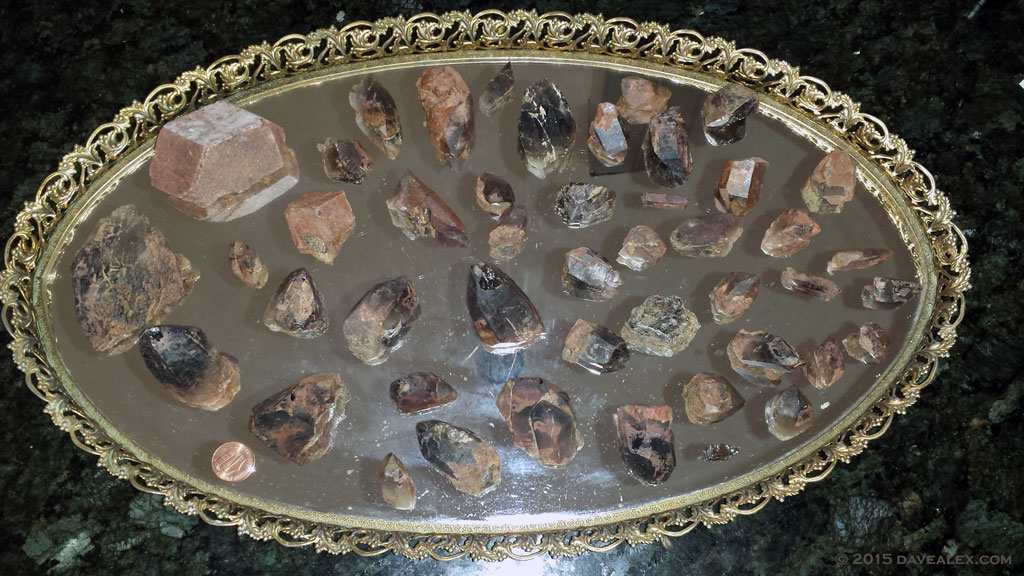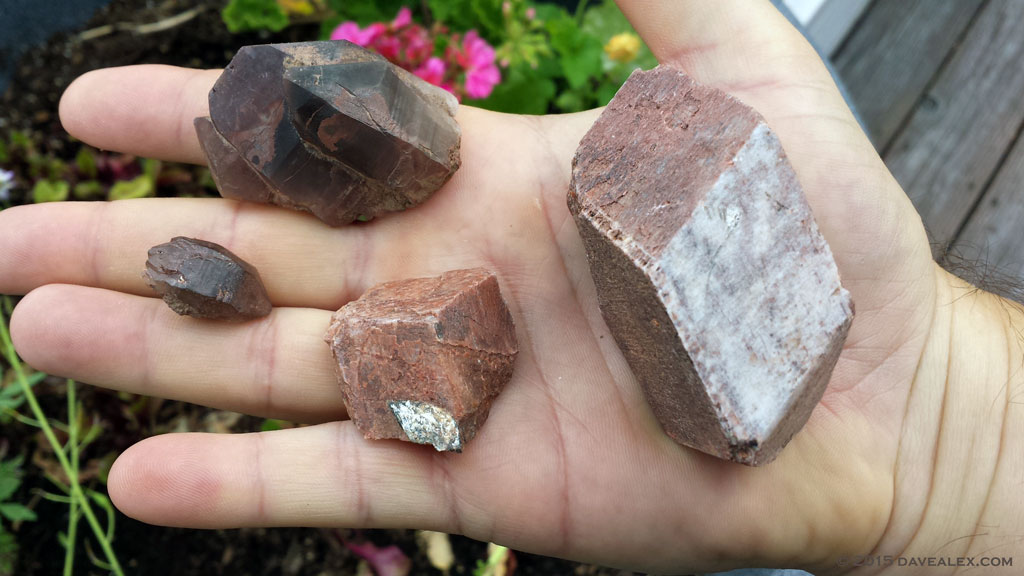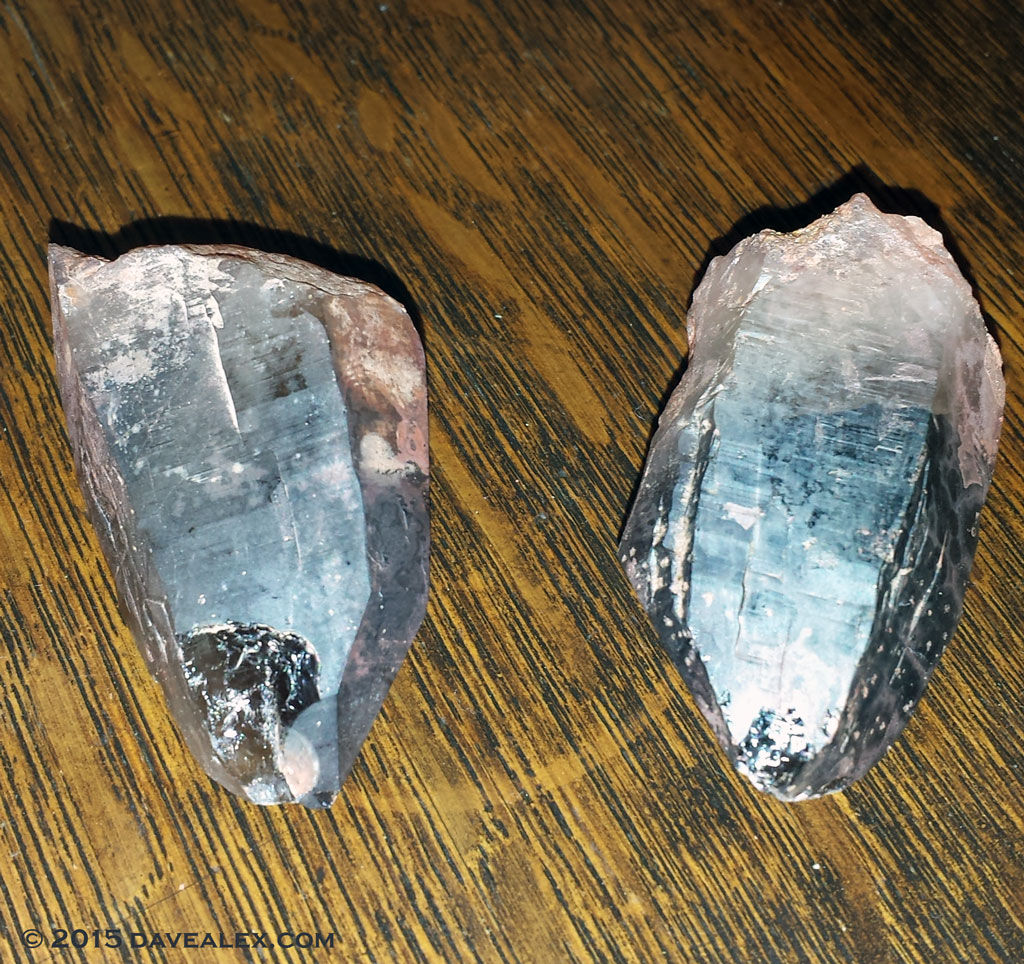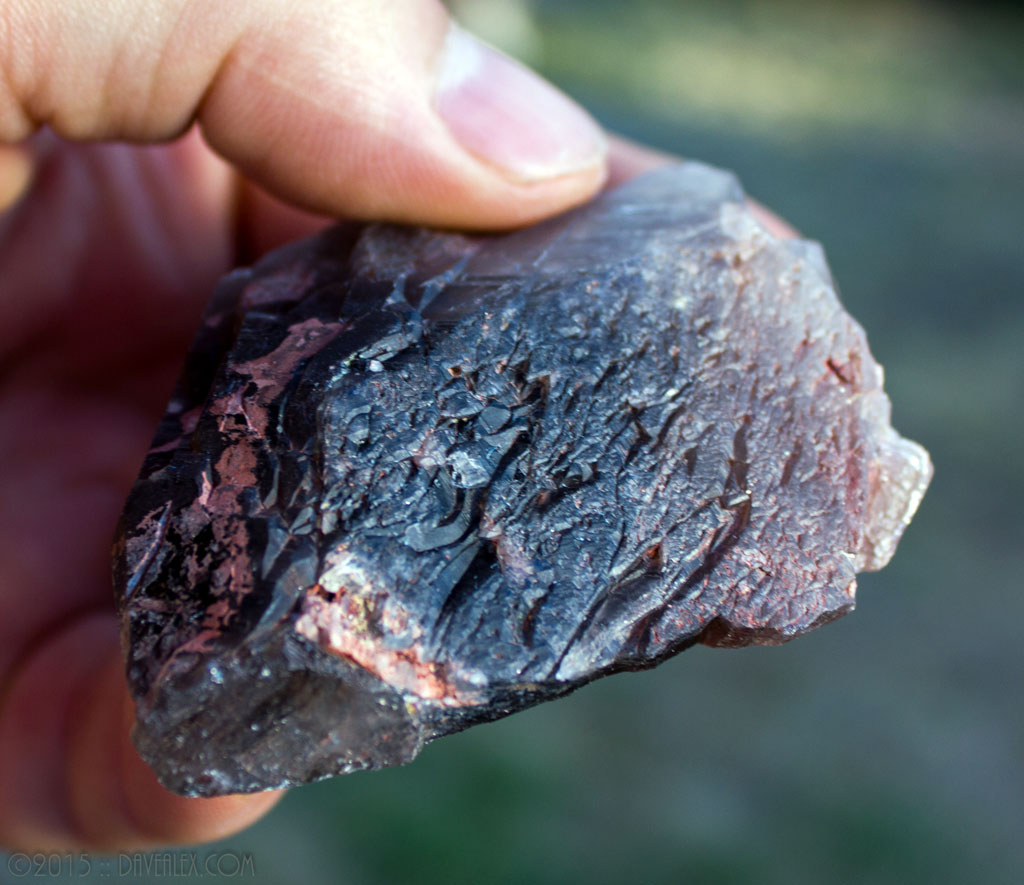Was able to break away from work so I took a vacation day and went up to Devil’s Head digging this last Friday. Been rough to get up there this year due to a busy schedule, but it was nice to be back out in the forest again.
I had a plan for this day–which I had been pondering upon over the last month while planning this trip. First thing I wanted to prospect an area that I remember looking promising a couple of years ago and if that didn’t pan out I wanted to dig some float on a very old dig I found that seemed pretty productive to the original prospector. If I got skunked with both parts of the plan I had a third option that was within a mile.
I stopped several times during my prospecting and checked out what looked to be good ground in many places. There was peg showing on the surface–both quartz, feldspar and combos–but the quartz was very striated, fractured and had no flat faces at all. I found many places along this steep hillside with the same situation, even though there was a lot of “good looking” signs on the surface. I ended up finding one rough point about the diameter of a nickel in one spot, but nothing otherwise. The hill was *very* steep and after nearly 4 hours I got tired of all the climbing and precarious hiking so I decided to give up on that area.

My second stop was about 1/2 mile away and was a old dig that someone obviously had success with as they had excavated a trench about 50 foot in length as they followed the pegmatite dike across the hillside. I could tell the dig was really old because the trench had naturally filled in most of the way and was looking pretty filled in. I believe this is why the Forest Service is okay with leaving holes unreclaimed as over time they naturally fill back in, although I still believe to fill in my holes as it takes a long time for nature to do it; and holes are simply an eyesore in our forest and potentially dangerous to animals!
My goal at this location was to see if I could find float or perpendicular seams coming out of the peg with some nice sized crystals (given the dig was fairly large). In other spots I have found my best crystals not in or under the pegmatite dike but rather coming out perpendicular to it in many spots in smaller peg seams. I also figured as I got into the old diggings I could possible see what the person was into–I always like to analyze others’ digs as this is a primary way I learn!
I started digging about 4-6 feet downhill of the old trench about 2-4 feet wide and a couple of feet deep. It was hard to tell if I was just digging in tailings or actual virgin ground below the trench, but soon I started finding crystal parts which narrowed my focus. Quickly I zoned in upon a small seam with microcline and smoky quartz crystals. Some were nice and I kept them; but most were only partially euhedral which was a sign of a smaller, tighter seam–even though some of the crystal parts were 5-7 inches long!
The crystals were organized to make me think this was not float (i.e. eroded crystals that eroded and rolled downhill from the pocket) as evidence of microcline and crystals next to each other and some red stained dirt. They definitely were in loose dirt and not harder rock. I followed this seam at a angle of about 30 degrees from straight downhill (I was on a very steep hill) for about 25-30 feet until it disappeared. The further downhill I went the smaller the crystals shards were, the less smoky in color and less frequent. The last 20 feet or so didn’t have anything worth keeping.

As I made my way into the old trench from below I started hitting larger masses of pegmatite (like three feet deep), this was the original peg that the prospector followed across the hillside. The digger left many crystals along the bottom of that seam and had obviously found a crack in the peg that had crystals, which is where I often also find my crystals. The unfortunate thing was that the digger obviously used metal tools in this seam and most of the crystals he left attached to the bottom of that seam were damaged on their points. Obviously the digger was finding nice crystals because they didn’t care about the nice 2-3 inch ones they were damaging all along the bottom of the small pocket/seam. Moral of that story, don’t use metal tools in your pockets and take your time, unless you don’t care about the “little guys”!

I dug until the sun was setting (beautiful sunset) and it started to sprinkle, since I had a heck of a hike (about a mile with some steep hills) back to the car I didn’t want to wait and have it get dark. As always, had a blast being out in the forest prospecting and was able to prove that–whether it is float or a perpendicular seam–there are sometimes crystals left behind by other prospectors and available if you put in the work from previous digs. This is definitely easier than prospecting good ground signs and striking into virgin ground, which likely will improve the chances of finding crystals quickly?


I am just getting started with the fun of rockhounding, and I have been up to Devil’s Head a few times this past summer/fall. I am having a tough time finding much, which I suspect is because I am doing it all wrong 🙂 My biggest question is this: when you are finding quartz ‘in’ the pegmatite, does that mean that you are actually digging into the hard rock? Or do you find ‘weak’ areas in the peg and find the crystals there? I have studied several dig sites- I feel like people dig into, under and all along the pegs- not to mention the several holes dug around tree trunks! I am not opposed to digging into the peg, but I definitely would rather use my energy in a productive manner, and that seems like hard work! Any tips would be much appreciated. I have mostly hung out around the Topaz Point picnic area and the campground area across the road. I did find some small but beautiful smokies in that area, so at least that’s a start!
Jennifer. Glad you are enjoying picking crystals!
Trees: I’ve had limited success picking a tree and then digging under it; and yes I’ve tried MANY times over the years. Like you, I’ve seen many digs on trees and heard about tree root pockets (especially with spectacular Amazonite plates coming out of the “Tree Root Pocket” on the Two Point Claim that is seen in magazines and museums)! My theory is that trees like water, and crystal pockets many times have clay which holds water, so trees are attracted to that. The roots also just grow in search of water, and the cracks in the rock allow the roots to go through where it is harder around the cracks. Path of least resistance type of thing.
In the pockets I’ve found I have nearly always found roots growing through them, I’ve seen trees, other plants, and sometimes unknown roots as the source. I just found this last week where a tree was growing on the Peg but with no real pocket underneath. I’ve (and other prospectors I’ve talked with) gone where trees have fallen and where tornadoes have uprooted them without much success seeing signs, but I still look them over every time in the hopes of a lucky find! So I use trees as a “hint” especially when there is peg around them or the peg dike is pointing towards a tree.
Pegmatite:
I’m still a novice and would love to hear more from other experts too, but in my experience I’ve seen a couple “types” of peg with crystals. The first type is where you are hitting a somewhat solid mass of peg in a dike. The crystals seem to form in a seam in the middle of the peg. Hard rock on top, hard rock on bottom. When that seam/crack opens up the crystals get bigger, when the seam gets smaller there are no crystals; but keep following that seam as long as the peg continues as it often opens back up. I’ve seen videos of Brazil pegs where they show the pocket zones of the peg follow around the central core, and there are pockets after pockets along the peg dike!
When in those seams and the crystals are surrounded by gravel or gravel-like material, many times in red or even purple colored material, you’re in the zone! Those “pockets” or seams sometimes get wider and even dive down; when the latter occurs that is where the crystals get nicer or at least more interesting (or sometimes so overcoated and etched they are hardly worth extracting and definitely not worth cleaning). The key, when you are into good peg, follow it.
I find these peg dikes by following float (usually uphill); digging these takes a considerable amount of energy as you have to dig around (and under) the rock so you can pry it out, often taking the layer of dirt/rock from the top to allow you to pry it out. Having a nice pick or prybar and the user of physics/leverage is key in the extraction process!
Sometimes the peg is less solid and more in smaller chunks, which means it has decomposed more over the millions and millions of years. You may find quartz or microcline with sides leading to the peg, and/or on top of the peg. I have found that sometimes the quartz is not quite formed but rather loose surrounded by the harder rock (you mentioned this in your question); and sometimes you’ll find faces (one or two, or more) in that quartz showing it was getting its act together and forming the crystals we like. Make sure and dig all around these areas (especially down) as sometimes that quartz vein is not where the crystals will come from; but rather they come from near or around that vein.
Look for graphic granite as well. The more the quartz/feldspar combine, and get larger crystallization side by side, this is a good thing to look for. I have noticed in several seams/pockets that the microcline crystallization is at the opposite end of the quartz crystallization. So if you are getting the microcline sides, make sure and dig around that area. Either way, if you are getting faces you are in the zone and keep going! If you are in the harder, larger rock and have areas of looser material, especially quartz, you are likely in a good spot. While in harder rock, gravel surrounded by hard rock is a good sign. If you are seeing mica, especially books, you are in a good spot. If you are in hard rock (or sometimes soil) and see red/purplish sections follow that–this is where at different times superheated liquid with higher iron concentrations has flowed through the cracks in the hard rock/veins, leaving its footprint.
Always check out other digs too especially if they are big (obviously someone wouldn’t work on that hole for that long if they were finding nothing). I have found many times where a section of the pocket/seam was missed; or that the dike continues on and it closes and opens up periodically. That is evident by the long trenches across the hills you see when prospecting other digs. I also have dug down from big digs finding some nice float downhill…kinda the opposite of trying to locate the original pocket; find what eroded out of the pocket if you know where the pocket is…
There are a lot of good signs to look for, but bottom line you need to find the signs of peg; which is typically around where there is quartz. Some that I have talked to have gotten quite lucky right away in their digging, and learned quickly because of that. It has taken me a while to figure it all out, and I’m still actively learning things. I also highly recommend rock clubs as there are great people with vast experience that would be more than happy to SHOW you things. Also when prospecting take some time to think about how everything formed; the lay of the land, and how these dikes flow across the hillsides. Having a creative imagination has paid off before for me!
Does any of this help?
–dave
Thanks for all the great tips, I am sure it will really help! I am planning to join the Flatirons Mineral Club since it’s the closest club to where I live. I also really look forward to learning on field trips. It seems with the recent snow I will have all winter to do more research and hopefully will be more productive (and lucky) next spring! Thanks again for taking the time to write your blogs and help a fellow rockhound out! Maybe we will bump into each other at Devil’s Head someday 🙂
Hi Dave,
I really appreciate and enjoy your reports. My wife and I are new to crystal prospecting and hunting and are from Wichita, KS. We were in the Devils Head area last June, even made it down to Topaz Point picnic area. When you mention float, is the float actually quartz crystal pieces or just quartz on the ground? We stopped at one place and noticed alot of quartz. We were unsuccessful at finding any crystals and want to get again next summer.